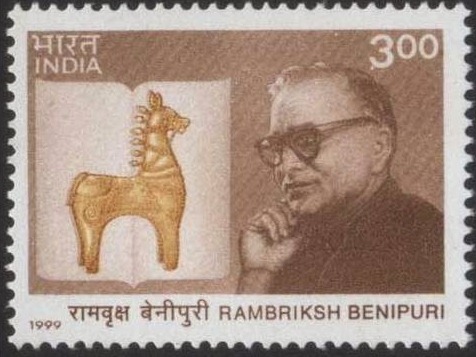By Ravi Kumar, Founder, Modlingua Learning, New Delhi
The selected hindi text is part of a short story “Razia’, Maati ki Mooraten –A collection of short stories by written by Ram Briksh Benipuri, during 1941-45. Benipuri was born in the Benipur village of Muzaffarpur district of Bihar. He was freedom fighter and worked closely with Mahatma Gandhi.
He is known for using subject oriented approach. His stories excavate layers after layers of his deep wisdom about people; his close observation of human nature goes beyond superficial evaluation.
Source Text
कानों में चाँदी की बालियाँ, गले में चाँदी का हैकल, हाथों में चाँदी के कंगन और पैरों में चाँदी की गोड़ाँई – भरबाँह की बूटेदार कमीज पहने, काली साङी के छोर को गले में लपेटे, गोरे चेहरे पर लटकते हुए कुछ बालों को संभालने में परेशान वह छोटी सी लड़की, जो उस दिन मेरे सामने आकर खङी हो गई थी – अपने बचपन की उस रज़िया की स्मृति ताज़ा हो उठी, जब मैं उस दिन अचानक उसके गाँव जा पहुँचा।
हाँ, यह मेरे बचपन की बात है। मैं कसाईखाने से रस्सी तुड़ाकर भागे हुये बछङे की तरह उछलता हुया अभी-अभी स्कूल से आया था और बरामदे की चौकी पर अपना बस्ता –सिलेट पटककर मौसी से छठ में पके ठकुए लेकर उसे कुतर कुतरकर खाता हुआ ढेन्की पर झुला झूलने का प्रयास कर रहा था कि उधर से आवाज़ आई – “देखना बबुआ का खाना मत छू देना”। और, उसी आवाज़ के साथ मैंने देखा, यह अजीब रूप – रंग की लड्की मुझसे दो – तीन गज आगे खँड़ी हो गई।
Literal Translation
That small girl, putting silver rings in the ear, silver necklace in the neck, silver bracelets in the hands, silver loops in the legs, with embroidered full sleeve shirt, black border of saree wrapped around the neck, being troubled by her hanging hairs on the white face, suddenly stood in front of me, suddenly that day when I reached her village, memory of Razia become fresh in my mind.
Yes, this fact is related to my childhood. I had returned home from the school. This was as equal as calf being freed from the butcher’s house. And I threw my school bag and silate, and began trying to play on dheki by making it play like see-saw biting thekua of chhat that my maternal aunt had made. Suddenly I heard voice coming, “Be aware, don’t touch food of the child:” And, with that voice, I saw, the strange looking girl, stood in front of me maintaining a distance of two to three yards.
Domestication and Foreignization of translation
Silver rings in the ears, a silver necklace, argentine bangles in the hands and loops in the legs; wearing a full-sleeve, long, embroidered blouse, coiling the border of the black Saree round her neck, frequently arranging her curly locks that played on the face of that lovely little blonde girl who stood that day before me, instantly reminded me of that Razia of my childhood days.
Oh, yes ... this is a sweet episode of my early years. Like a calf who unloosened herself from a butcher house, I just had arrived from school -- happy and playful! I thumped my school bag on the cot in the verandah and was enjoying a see-saw on the dheki while nibbling the thekua of the Chhath my Mausi gave me when suddenly I heard a voice: “Oh, take care, don’t touch Babua’s food”. And with this, I saw that a strange girl stood in front of me at a distance of few yards.
Conclusion
Even for making literal translation, it becomes important for the translator to reach (as near as possible) the author and his time and space where he lived in. For literal translation, locating exact meaning is a major challenge, and many times, the translator is forced to reach a compromise with a word in target language. The chosen compromise results in creating a distance in achieving intended meaning and flavor. Following purely Schleiermacher’s concept of bringing reader to author (foreignization) through literal translation the translator ends up missing the spirit of the language as well as the intent of the author. In fact, translation becomes word to word and too heavy with foreign words. Thus for coming closer to the author, the reader may need to study the background of the author, language as well as culture in which the text was written. This sort of translation becomes easier to produce, and it may not be considered an act of art at all.
On the other hand, if translator tries to bring author to the reader (domestication) by bringing adaptive translation, it demands a deeper understanding of text as well as context. Thus the translator needs detailed understanding of purpose of translation along with social, political and cultural context followed by ideological background of the writer. All these elements help translator maintain purpose, beauty and sprit of the language as well as ease of the reader.
It may also be noted that it becomes rather impossible for the translator to follow a particular set of strategy and get intended results. One is compelled to go against the advice of Schleiermacher, who suggests not to mix two of his strategies, “1) either the translator leaves the writer alone as much as possible and moves the reader toward the writer, or2) he leaves the reader alone as much as possible and moves the writer towards the reader”. Translator is compelled to make use of combination of strategies to liberate power of Source Text (Benjamin) in the Target text. In the improved version of translation above, Blendlinge (Venuti) of the two strategies suggested by Schleiermacher along with mediation of intercultural elements was used. Nida’s concept of formal as well as dynamic equivalence helped understand the problem in a much better way, as it gave clear choice to either maintain only form and content of the text or try and maintain dynamic relationship between receptor and the message by trying to complete naturalness of expression and relate the receptor to modes of behavior relevant within in the context of his own culture.






